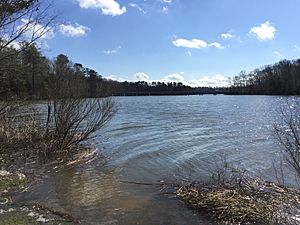College Creek facts for kids
College Creek is a stream in James City County, Virginia. It flows into the James River. This creek was once called Archer's Hope Creek. It starts near the city of Williamsburg. The creek is an important part of the Virginia Peninsula area.
Contents
A Look Back: The 1600s
When English settlers first arrived in Jamestown in 1607, they explored the area. A stream nearby was named Archer's Hope Creek. It was named after Gabriel Archer, an early explorer. He thought this spot would be a great place for a settlement. The land seemed good for farming. There was plenty of wood and wildlife. It also looked easy to defend. But, the ships could not get close to the shore. So, the settlers chose Jamestown instead. Today, you can visit a scenic spot called Archer's Hope along the Colonial Parkway.
Building a Big Wall
Archer's Hope Creek was very important in early Virginia. It drained the southern part of the Virginia Peninsula. In the 1630s, it became part of a major defense plan. The idea was to build a long wall, or palisade, across the peninsula. This wall would protect the settlers.
The idea for a palisade came up around 1611. But, there was a time of peace with the Powhatan Native Americans. This was after John Rolfe and Pocahontas married in 1614. So, nothing was built right away.
A Time for Protection
After a big conflict in 1622, the idea of a wall came back. Many settlers were killed. Governor Francis Wyatt and his team thought about building a wall. It would stretch between the James and York Rivers. This would help protect the colonists.
Dr. John Potts helped start the project. He got land near the head of Archer's Hope Creek in 1632. This spot was halfway between the James River and the York River. The Virginia General Assembly encouraged people to settle in this area.
Work on the palisade began in February 1633. Settlers worked together to build houses and secure the land. The palisade was about six miles (10 km) long. It ran from Archer's Hope Creek to Queen's Creek. Queen's Creek flowed into the York River. These two creeks and the palisade created a barrier from river to river. A new settlement called Middle Plantation grew up in the middle of this barrier.
The Palisade's Impact
By 1634, the palisade was finished. It gave settlers more safety from Native American attacks. They could farm and fish further down the peninsula. Middle Plantation became a growing community.
After 1644, the Native Americans were no longer a threat. The palisade slowly fell apart. But Middle Plantation kept growing. Important people like the Ludwell brothers and Colonel John Page helped it develop. They built nice brick homes. They also helped build the Bruton Parish Church.
Middle Plantation Becomes Williamsburg
In the 1690s, Middle Plantation became even more important. Reverend Dr. James Blair helped start a new school. It was called The College of William and Mary. The college bought land on the edge of Middle Plantation. The first college building, the Wren Building, was built there in 1695. It was ready by 1700. The college is still there today.
In 1698, the government building in Jamestown burned down. The government moved to Middle Plantation temporarily. Students from the college suggested that Middle Plantation become the permanent capital. In 1699, it was renamed Williamsburg. Archer's Hope Creek was also renamed. It became College Creek.
The 1800s: A New Defense Line
In the mid-1800s, during the American Civil War, College Creek was used again. It became part of another defense line. This was called the Williamsburg Line. It was a series of 14 small forts, or redoubts, east of town. Fort Magruder was the main fort. It was at a key spot where two main roads met.
Benjamin Stoddert Ewell, the president of the College of William and Mary, helped design these defenses. He became an officer in the Confederate Army. The college closed during the war.
The Battle of Williamsburg
In the spring of 1862, there was fighting near Williamsburg. This was part of the Peninsula Campaign. Union forces tried to capture Richmond, the Confederate capital. Confederate General John B. Magruder used clever tricks. He made his small army seem much larger. This slowed down the Union advance. It gave the Confederates time to build defenses for Richmond.
In early May 1862, the Confederates slowly left their first defense line. Union General George B. McClellan chased them. A Confederate rear guard, led by General James Longstreet, stopped the Union forces at the Williamsburg Line.
The Battle of Williamsburg happened on May 5 and 6, 1862. The city eventually fell to the Union. However, the Confederate defenders had succeeded. They delayed the Union army long enough for the main Confederate forces to reach Richmond safely. This led to a siege of Richmond. McClellan's campaign failed. The war continued for almost three more years. Williamsburg was occupied by Union troops until September 1865.
Modern Times: The 1900s and 2000s
In 1957, a bridge was built over College Creek. This was for the new Colonial Parkway. It was finished for Jamestown's 350th anniversary. The Williamsburg Airport was also built nearby. More recently, a four-lane highway, State Route 199, crosses College Creek. It uses two large bridges. The newest bridge was finished in 2006.
College Creek Today
Today, the area around College Creek is called its watershed. This is the land where all the rain drains into the creek. The College Creek watershed in James City County includes several neighborhoods. These are Kingsmill, Kingspoint, James Terrace, and the Vineyards. It also has Kingsmill Pond, the Busch Corporate Center, and the Anheuser-Busch Brewery.


